|
|
Vectors in a Plane and Space |
|
|
|
|
|
Vectors
in a Plane |
 Vectors - introduction
Vectors - introduction |
|
Length, magnitude or
norm of the vector |
 Collinear, opposite
and coplanar vectors
Collinear, opposite
and coplanar vectors |
 Addition of vectors
Addition of vectors |
|
Triangle rule (law)
and parallelogram rule |
|
Zero or null vector |
 Subtraction of vectors
Subtraction of vectors |
 Scalar multiplication
or multiplication of a vector by scalar
Scalar multiplication
or multiplication of a vector by scalar |
|
|
|
|
|
|
|
| Vectors - introduction |
There are physical quantities like force, velocity, acceleration and others that are not fully determined by their
numerical data.
|
| For example, a numerical value of speed of motion, or electric or magnetic field strength, not
give us the information about direction it move or direction they act.
|
Such quantities, which are completely specified by a magnitude and a direction, are called vectors or vector
quantities and are represented by directed line segment. |
| Thus,
a vector is denoted as
|
 |
where the point
|
|
|
A is called the tail or start and point
B, the head or
tip.
|
| The length or magnitude or norm of the vector
a
or |
 |
is |
|

|
| Therefore, the length of the arrow represents the vector's magnitude, while
the direction in which the arrow points, represents the vector's direction. |
|
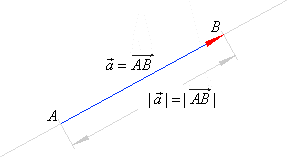 |
|
| A vector with no magnitude, i.e., if the tail and the head coincide, is called the
zero or null vector
denoted |
 |
|
|
| Collinear, opposite
and coplanar vectors |
| Two vectors are said to be
equal if they have the same magnitude
and direction or if by parallel shift or translation one could be
brought into coincidence with the other, tail to tail and head to
head.
|
|
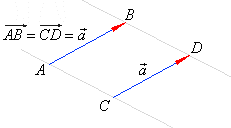 |
|
| Vectors are said to be
collinear if they
lie on the same line or on
parallel lines.
|

|
| Vectors,
|
 |
in
the above figure are
collinear. |
|
| Two collinear vectors of the same magnitudes but opposite directions are said to be
opposite vectors. |
| A vector that is opposite to |
 |
is
denoted |
 |
as shows the
above right figure. |
|
|
Three or more vectors are said to be
coplanar if they lie on the same plane. If two of three vectors are collinear then these vectors are coplanar.
|
| To prove this statement, take vectors,
|
 |
of which
|
 |
are
collinear.
|
|
|
By using translation bring the tails of all three vectors at the same point. Then, the common line of
vectors,
|
 |
and the line in which lies the vector
|
 |
determine the unique plane. |
|
| Therefore, if vectors are
parallel to a given plane, then they are coplanar.
|
|
| Addition of vectors |
| The sum of vectors, |
 |
can be obtained graphically by placing the tail of |
 |
to the tip or head of |
 |
|
| using translation.
Then, draw an arrow from the initial point (tail) of |
 |
to the endpoint
(tip) of |
 |
to obtain |
|
| the
result. |
 |
| The
parallelogram in the above figure shows the addition |
 |
where, to the tip of |
 |
by translation, placed |
|
| is the tail of |
 |
then, drawn
is the resultant |
 |
by joining the tail of |
 |
to the tip of |
 |
|
|
| Note that the tips of the resultant and the second summand should coincide. |
| Thus, in the above figure
shown is, the triangle
rule (law) and the parallelogram
rule for finding the
resultant or
the addition of the two given vectors. The result is the same
vector, that is |
 |
| Therefore, vector addition is commutative. |
| Since vectors, |
 |
form a triangle, they lie on the same
plane, meaning they are coplanar. |
|
| |
| Addition of three vectors,
|
 |
is defined as
|
 |
and represented graphically
|
|
|
|
| The
above diagrams show that vector addition is
associative, that is |
 |
|
| The same way defined is the sum of four vectors. |
|
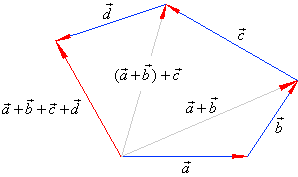 |
|
| If by adding vectors obtained is a closed polygon, |
|
then the sum is a null vector. |
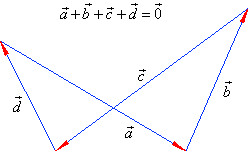 |
|
|
|
| By adding a vector |
 |
to its opposite vector |
 |
,
graphically it leads back to the initial point, therefore |
|
|
 |
so, the
result is the null vector. |
|
|
|
| Subtraction of vectors |
| Subtraction of two vectors,
|
 |
is defined as addition of vectors
|
 |
that is,
|
|
|
 |
| As shows
the right figure, subtraction of two vectors can be accomplished directly.
|
|
|
| By using translation place tails of both vectors at the same
point and connect their
tips. |
|
| Note
that the arrow (tip) of the difference
coincides with the tip of the first
vector (minuend). |
|
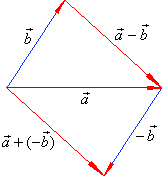 |
|
|
| Scalar multiplication
or multiplication of a vector by scalar
|
| Scalar is a quantity which is fully expressed by its magnitude or size
like length, time, mass, etc. as any real number.
|
| By multiplying a vector
a
by a real number
l
obtained is the vector l
a
collinear to
a
but,
|
| l times longer
than a
if | l
| > 1,
or shorter than a
if
| l
| < 1,
and |
|
directed as a
if l
> 0,
or opposite to a
if l
< 0,
|
|
as is shown in the below figure.
|
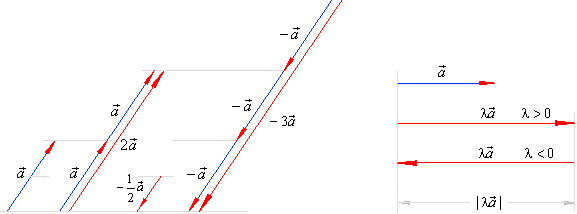 |
|
| Thus, the magnitude of the vector
l
a
equals to the product of the absolute value of the real number
l
and the magnitude of the vector a, that is |
 |
|
| Besides, for the multiplication of a vector by a real number
following rules hold:
|
| 1)
l
· ( a + b ) = l
a + l
b |
| 2)
( l
+ m
) · a = l
a + m
a,
l,
m
Î R |
| 3)
l
( m
a ) = m
( l
a ) = ( m
l
) a |
| 4)
1 · a = a,
-1
· a = -
a |
| 5)
0 · a = 0,
m
· 0 = 0 |
|
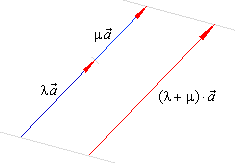 |
|
|
| In the similar triangles
ABC and
ADE
in the
right |
| figure,
AE
: AC
= DE
: BC
= AD
: AB
= l |
| therefore,
AE
= l
· AC. |
| Since
AE
= l
a + l
b
and AC
= a + b |
| then,
l
a + l
b = l
· ( a + b ). |
|
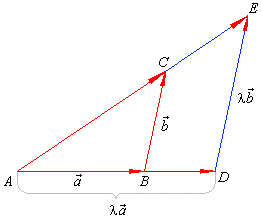 |
|
|
|
|
|
|
|
|
|
|
|
|
| Vectors
in 2D and 3D Contents |
|
 |
|
| Copyright
© 2004 - 2020, Nabla Ltd. All rights reserved. |
|
|